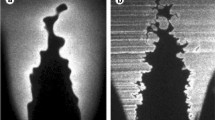Abstract
In this paper a calculation procedure for simulating the combustion flow in the afterburner with the heat shield, flame stabilizer and the contracting nozzle is described and evaluated by comparison with experimental data. The modified two-equationk – ɛ model is employed to consider the turbulence effects, and thek – ɛ –g turbulent combustion model is used to determine the reaction rate. To take into account the influence of heat radiation on gas temperature distribution, heat flux model is applied to predictions of heat flux distributions. The solution domain spanned the entire region between centerline and afterburner wall, with the heat shield represented as a blockage to the mesh. The enthalpy equation and wall boundary of the heat shield require special handling for two passages in the afterburner. In order to make the computer program suitable to engineering applications, a subregional scheme is developed for calculating flow fields of complex geometries. The computational grids employed are 100×100 and 333×100 (non-uniformly distributed).
The numerical results are compared with experimental data. Agreement between predictions and measurements shows that the numerical method and the computational program used in the study are fairly reasonable and appropriate for primary design of the afterburner.
Similar content being viewed by others
References
Zhao, J.X. and Andrews, G.E. “Numerical Modelling of Confined Swirler Stabilised Premixed Flames,” ICAS Proceedings, Sweden, p.948, (1990).
Mason, H.B. and Spalding, O.B. “Prediction of Reaction Rate in Turbulent Premixed Boundary-Layer Flow,” Combustion Institute European Symposium, (1973).
Zhao, J.X. and Yi, Y. “Numerical Study on Turbulent Combustion Model,” Proceedings of 2nd APISCEU, Bei**g, (1993).
Gasman, A.D. and Lockwood, F.C. “Incorporation of a Flux Model for Radiation into a Finite-Difference Procedure for Surface Calculation,” Fourteenth Symposium (Int.) on Combustion, Petersburg, p.611, (1972).
Khalil, E.E. «Modelling of Furnaces and Combustors», Press ABACUS, Kent (1982).
Baker, S.J. and McGuirk, J.J. “Multijet Annulus/Core-Flow Mixing Experiments and Calculations,”J. of Engineering for Gas Turbines and Power,”115, 473, (1993).
McGuirk, J.J. and Palma, J.M.L.M. “The Flow Inside a Model Gas Turbine Combustor: Calculations,”J. of Engineering for Gas Turbines and Power,115, 594, (1993).
Author information
Authors and Affiliations
Rights and permissions
About this article
Cite this article
Zhao, J., Liu, Q. & Liu, H. Flow field calculations for afterburner. J. of Thermal Science 4, 129–135 (1995). https://doi.org/10.1007/BF02653197
Issue Date:
DOI: https://doi.org/10.1007/BF02653197




